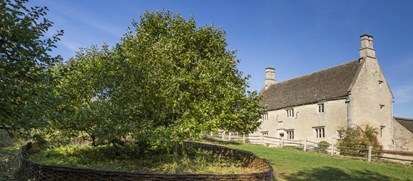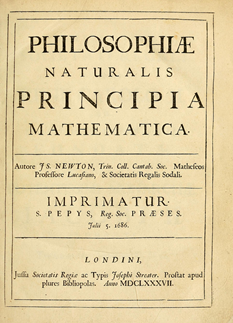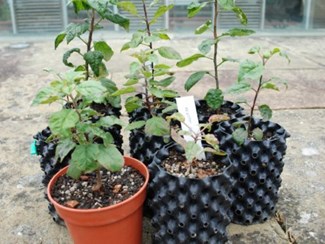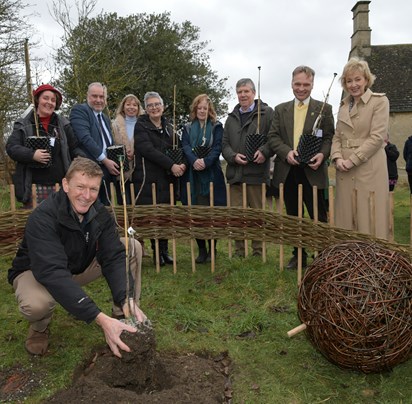|
Woolsthorpe Manor, Sir Isaac Newton’s family home near Grantham, Lincolnshire, is the home of the the tree, which said to have prompted Newton to question why the apple fell, leading to his world-changing The tree is approximately 400 years old, and still bears fruit every year. The house is now cared for by the National Trust. |
 |
 |
In 2015 some pips were taken from this iconic ‘Flower of Kent’ apple tree where, allegedly, an apple fell on Isaac Newton's head, leading to his thoughts on gravity. Newton's landmark work on gravity, first published in 1687, called |
| The apple pips were taken to the International Space Station on the British ESA astronaut’s ‘Principia’ mission, where they spent six months floating in micro-gravity as part of the ‘Pips in Space’ project. |
 |
 |
On their return from space in 2016, the well-travelled pips went to Wakehurst Place, part of the Royal Botanic Gardens, Kew, where they spent 90 days sitting on a bed of agar jelly at 5 degrees C to simulate the winter cold needed to trigger germination. Spring arrived for them in May 2017 when they were warmed to 15 degrees C and 8 young seedlings started to emerge. They have now been nurtured into ‘space saplings’. Just eight of them survived |
|
The UK Space Agency, the National Trust and Kew teamed up to launch a competition to find worthy homes for these 8 unique saplings. The winners were chosen from 50 bidders, one of which was a joint entry between the Environmental Education Project at Rosliston Forestry Centre, and Rosliston Astronomy Group The Presentation Ceremony took place on 13 January 2020, at Woolsthorpe Manor where one of the Space Saplings was planted by Tim Peake, to grow opposite its parent tree. The photo shows the representatives from each organisation, along with Tim Peake, and Angela Leadsom MP |
 |
|
The seven ‘Custodian’ Organisations selected to have the future care of these precious items, in addition to Woolsthorpe Manor itself, were:- |
• Eden Project (Cornwall) • Jodrell Bank Discovery Centre (Cheshire) • Brogdale Collections, Home of the National Fruit Collection (Kent) • Catalyst Science Discovery Centre (Cheshire) • Royal Parks and National Physical Laboratory (Middlesex) • South Derbyshire District Council, Environmental Education Project, at Rosliston Forestry Centre (South Derbyshire) (This is the Partnership with Rosliston Astronomy Group) • United Nations Office for Outer Space Affairs (Vienna) |
|
|
Kate Allies and Malcolm Rosburgh from South Derbyshire Environmental Education Project (far left and far right), (centre) Heather Lomas and Ed Mann from Rosliston Astronomy Group, with Major Tim Peake |
| THE ROSLISTON SPACE SAPLING - 2020 AND BEYOND |
Following the Presentation in January 2020, the Space Sapling was cared for by the Environmental Education Team at Rosliston Forestry Centre, until planted.
|
|
The Space Sapling was planted on the same day as the Grand Opening of the Peter Bolas Observatory - 14th March, 2020. Prof. Chris Lee FRAS, Chief Scientist, UK Space Agency, performed the Ceremony. From left to right - Prof. Chris Lee, Frank McArdle, CEO, South Derbyshire District Council, Cllr Neil Atkin, Vice-Chairman, SDDC |
|
THE ROSLISTON SPACE SAPLING DIARY |
|
As planting took place towards the end of its winter dormancy period - we eagerly awaited the first signs of growth. Spring 2020 arrived but initially there was no sign of leaf development ...... and then, in May (23/05) we saw the first leaves begin to appear. We all breathed sighs of relief ! Will this be a pattern, we wondered ? Are any of the other seven Space Saplings across the country behaving in the same way ? Is the delayed leaf production typical of the 'Flower of Kent' apple, or is it scientifically significant - possibly linked to the specific conditions during its period of germination ? Its development in 2021 began to provide an answer ….. |
May 2020 |
|
June 2020 |
The Space Sapling during its first year at Rosliston ....
|
August |
|
October 2020 |
March 2021 |
|
As the ‘rootball’ at the time of planting was extremely small, it is taking time for the space sapling to become established. It is planted in a clay based environment and it is having to ‘work hard’. One of the other saplings planted near is also a ‘Flower of Kent’ - sourced from a nursery - which will be an interesting comparison as they develop. The late timing for coming into leaf continued in 2021, with the first leaf buds opening well after its companion saplings - but this time it was a month earlier (19/04). Will this be the pattern - as the roots become established and the rate of growth starts to increase, will the leaf emergence gradually become earlier in the year and become nearer to the timescales of the adjacent apple trees, year on year ? Growth progressed during 2021, albeit slowly, reaching 61cm at its tallest point at the end of the summer. In the Autumn of 2021 leaf drop matched that of the surrounding saplings. At the start of 2022 ‘Twiggy’ was pruned by the Environmental Education Team, but at the end of the growing season it’s height at the tallest point was 72cm. As was indicated in 2021, the Space Sapling’s natural growing ‘shape’ appears to be following that of its parent tree at Woolsthorpe Manor - squat, with a wider base. This was more evident in 2022, and required monitoring as the growing tips repeatedly came into contact with its protection cage during windy conditions. Leaf drop at the end of 2022 followed normal patterns. During the 2022/2023 dormancy period we wondered what would be the pattern of development through the 2023 growing season ….. This will be ‘Twiggy’s’ sixth growing season following emergence from its ‘Space Pip’ stage, at Wakehurst Place in May 2017. At the appropriate time during the Spring of 2023 ‘Twiggy’ had her second prune. This time between 15cm-25cm (6”-10”) were removed from a number of shoots. These have been prepared and planted in hopes that they will ‘strike’. Two have been set as grafts. On the day of the King’s Coronation ‘Twiggy’ stayed true to form and kept her leaf buds closely under wraps ! We await developments….. !
|